When I first rolled into Alsace eight years ago, I thought I’d stumbled into a fairytale that someone had accidentally left open. Half-timbered houses in pastel colors lined cobblestone streets, vineyards stretched across hillsides like green corduroy, and every village seemed to be in a competition for “most charming place in Europe.”
That first trip left such an impression that I had to return…and I’m glad I did. This past October, my wife and I decided to roadtrip through this magical corner of northeastern France, and I can confidently say that Alsace has earned its spot as one of my favorite regions in all 73 countries I’ve visited.
What makes Alsace special isn’t just one thing. It’s the way German and French cultures have blended into something entirely unique. It’s sipping Riesling in a winstub while autumn leaves drift past medieval windows. It’s the Vosges Mountains rising in the west and the Rhine River marking the German border to the east. It’s towns like Colmar, Strasbourg, and Riquewihr that make you wonder if you’ve somehow traveled back in time. Ahhh to be in Alsace.
After two visits and countless kilometers exploring every corner of this region—from the famous Route des Vins to hidden mountain villages most tourists never find—I’ve put together this ultimate guide to help you experience the very best of Alsace. I’ll show you exactly how to make the most of this enchanting region, from the must-see villages and road trip tips to the tastiest local dishes I’ve tried.
- Watch next: My Recent Instagram Stories of Alsace

Understanding Alsace: Location, History & Size
Alsace is that sliver of France tucked against the German border in northeastern France, sandwiched between the Vosges Mountains to the west and the Rhine River to the east. It’s small (just 190 kilometers from north to south), but packs an incredible punch for its size.
The region’s unique character comes from its complicated history. Alsace has changed hands between France and Germany multiple times over the centuries, most recently flipping between the two during the Franco-Prussian War, World War I, and World War II. This constant back-and-forth created a distinct culture that’s neither fully French nor fully German, but something wonderfully unique.
Today, Alsace comprises two departments: Bas-Rhin (Lower Rhine) in the north, home to Strasbourg, and Haut-Rhin (Upper Rhine) in the south, where you’ll find Colmar and most of the famous Wine Route villages. The entire region is roughly the size of Delaware…you can drive from the northern tip to the southern end in about two hours. The main attractions cluster along the eastern foothills of the Vosges, where centuries of winemaking have shaped the landscape into that iconic patchwork of vineyards, forests, and storybook villages. I’ll share my favorite spots below!

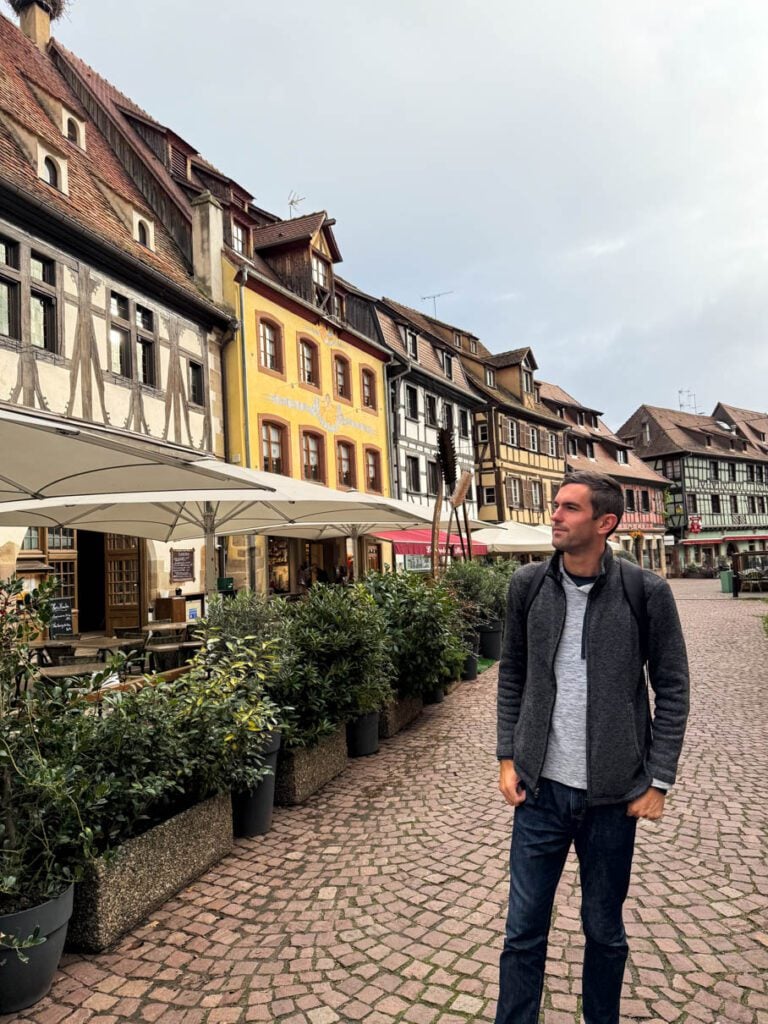
Why Visit Alsace?
Alsace is one of those rare places that feels like nowhere else on Earth. Tucked between France and Germany, this region has ping-ponged between the two countries throughout history. And rather than being torn apart by this identity crisis, Alsace has emerged with the best of both worlds. You’ll find French elegance in the wine, the cuisine, and the joie de vivre, while German influence shows up in the architecture, the language (many locals still speak Alsatian), and that characteristic efficiency. It’s a cultural cocktail you won’t find anywhere else in Europe.
My Favorite Part About Alsace: The Fairytale Villages!
The villages here don’t just look old…they look impossibly perfect, like someone’s idealized vision of what a European village should be. Riquewihr, Eguisheim, and Kaysersberg are just a few examples of towns where every corner seems designed for a postcard. Many of these villages are UNESCO World Heritage sites or designated as some of France’s “Most Beautiful Villages,” and they’ve been preserved with such care that walking through them genuinely feels like stepping back to the 16th century. The half-timbered houses (colombages) painted in pinks, yellows, and blues are absolutely incredible. And to my surprise, people actually live and work in these buildings, giving the towns an authentic, lived-in charm.
Alsace is for Foodies
If you’re a food and wine lover, Alsace will quickly become one of your favorite destinations. The region’s wines are world-class but refreshingly unpretentious. You can taste exceptional Riesling, Gewürztraminer, and Pinot Gris directly from winemakers in their family cellars. The food is hearty and delicious: think choucroute garnie (sauerkraut with sausages and pork), baeckeoffe (a slow-cooked meat and potato casserole), and flammekueche (the Alsatian answer to pizza, with crème fraîche, onions, and bacon). I’ve never had a bad meal here, and the wine pairings are always spot-on!
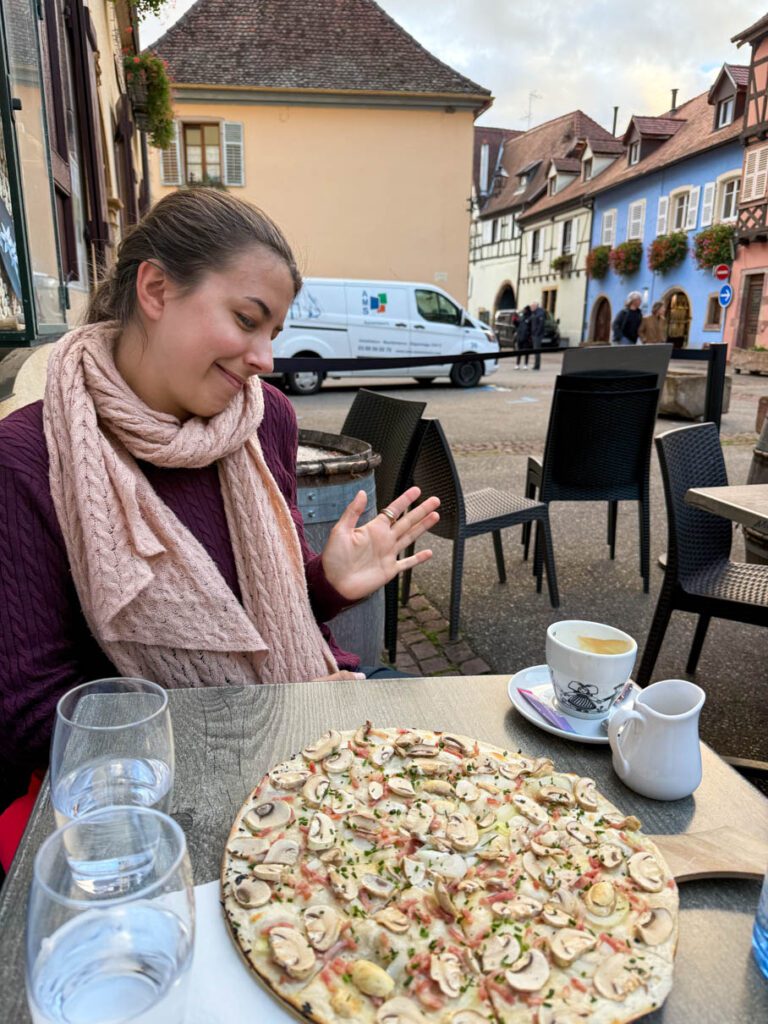
Alsace is Home to the Best Christmas Markets in Europe!
Come winter, Alsace transforms into Europe’s Christmas capital. Strasbourg hosts one of the continent’s oldest and most famous Christmas markets, drawing millions of visitors who come to wander through wooden chalets selling everything from handcrafted ornaments to vin chaud (mulled wine). Colmar’s markets are equally magical but slightly less crowded, and dozens of smaller villages host their own intimate versions. Even if you visit outside the holiday season, that festive, cozy atmosphere seems baked into Alsace’s DNA.
Breathtaking Nature for Photography
Beyond the villages and vineyards, the natural beauty here is stunning and surprisingly diverse. The Vosges Mountains form a dramatic backdrop to the west, offering hiking trails, mountain lakes, and panoramic viewpoints that reveal the entire Rhine Valley. The famous Route des Vins d’Alsace winds for 170 kilometers through vineyard-covered hillsides, connecting village after village in what might be France’s most scenic road trip. During my October visit, the autumn colors turned the vineyards into a patchwork of gold, orange, and crimson. It was genuinely one of the most beautiful landscapes I’ve photographed in 70+ countries!

Getting to and Around Alsace
One of the most common questions I get about Alsace is: “Do I really need a car?” The short answer: it depends on what you want to see. But let me walk you through all your transportation options, from getting to the region in the first place to navigating those winding village streets once you’re there.
How to get to Alsace
Getting there is straightforward. Fly into EuroAirport Basel-Mulhouse (best for southern Alsace), Strasbourg Airport (limited connections), or Zurich (two hours away). Coming from Paris? The TGV reaches Strasbourg in under two hours—book early on SNCF Connect for fares as low as €25.
Tips to see as much as possible
Now for the big question: do you need a car? If you’re only visiting Strasbourg and Colmar, no. Both cities are walkable with good train connections between them. But if you want to explore the Wine Route villages (and you absolutely should), a car is essential. Public transportation between villages is limited and time-consuming. I did that years ago, and wouldn’t do it again to be honest. The magic of Alsace happens when you can pull over at a beautiful vineyard, detour to a tiny village, or stop at a family winery on impulse.
✈️ My #1 Tip for Cheap Flights:
If you’re not using Going, you’re probably overpaying for flights. I’ve scored roundtrips to Europe for under $300 - and I never would’ve found them on Google Flights.
Their free version is great, but Premium is where the real magic happens. I recommend doing the 14-day free trial. And right now, you can get 25% off Premium or Elite with my code: JON25.
Seriously, it’s the best travel decision I’ve ever made (in 8+ years).
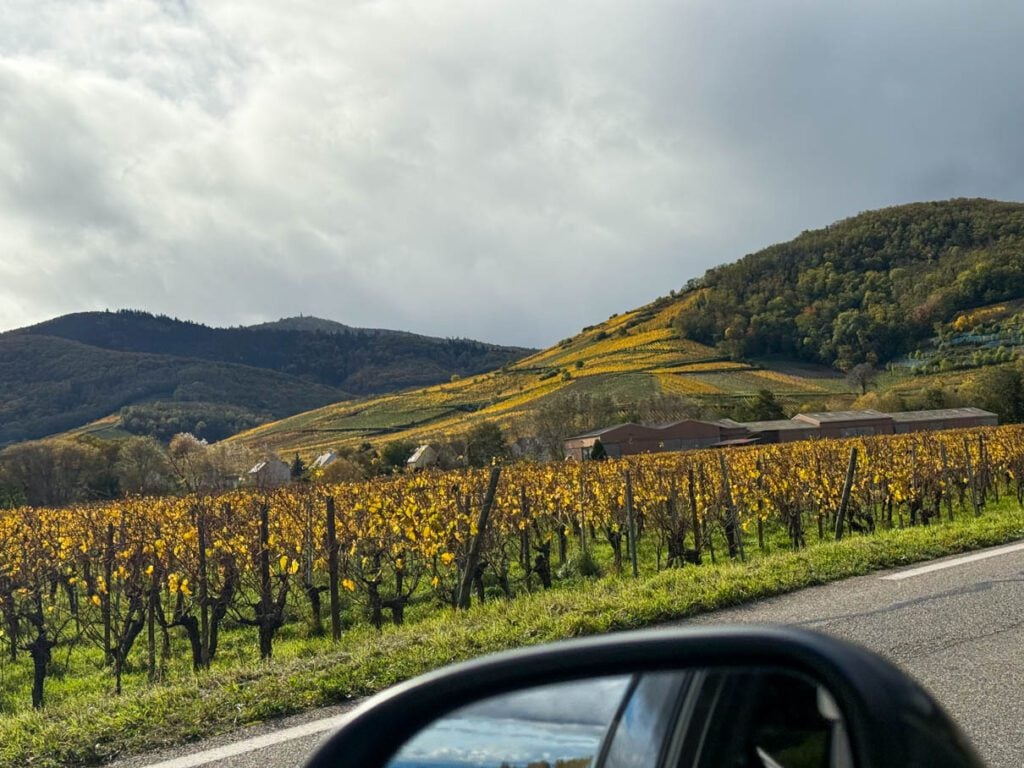
The Route des Vins is well-marked and easy to drive, though village streets are narrow. Park in designated lots on village outskirts (usually €3-5) and walk into historic centers. During peak season, drive before 9:30am or after 4pm to avoid crowds in popular spots like Riquewihr and Eguisheim.
Prefer not to drive? Guided day tours from Paris or Basel hit the highlights, though you’ll sacrifice flexibility. Check out options on GetYourGuide and Viator – I’ve linked to their Alsace tour collections, where you can filter by duration, price, and traveler reviews. E-bikes are increasingly popular for the Wine Route…rentals run €35-50 per day and let you cover serious ground without exhausting yourself before wine tastings.
- My advice: Rent a car for at least 2-3 days of your trip. Those will be the days you remember most.
Where to Stay in Alsace
Your choice of base will shape your entire Alsace experience. After two visits, I’ve stayed in both cities and villages, and each has distinct advantages. Here’s my breakdown of the best places to set up camp.
Strasbourg
- Best For: City vibes, history, cathedral views, and Christmas markets
Strasbourg gives you that urban energy while keeping its charming Alsatian character. The Petite France neighborhood is postcard-perfect with its canals and half-timbered houses, while the Gothic cathedral dominates the skyline. This is your best base if you want excellent restaurants, nightlife, museums, and the feeling of being in a real working city rather than a tourist village.
The trade-off? You’re about 30-45 minutes from the heart of the Wine Route, so you’ll spend more time driving to those fairytale villages.
- Luxury ($$$): Hôtel Cour du Corbeau – This 16th-century building overlooking the Ill River is pure elegance. The rooms blend historic architecture with modern comfort, and the location in Petite France can’t be beat. Expect to pay €200-350 per night.
- Mid-Range ($$): Hôtel Gutenberg – Right in the city center near the cathedral, this boutique hotel offers comfortable rooms with Alsatian touches. Great value at €100-180 per night, and you can walk to everything.
- Budget ($): Hôtel Le Grillon – A no-frills but clean and friendly option about 15 minutes from the center by tram. Rooms start around €70-90, perfect if you’re spending your days exploring rather than lounging in your hotel.

Colmar
- Best For: Central Wine Route access, romantic atmosphere, and day trips to villages
Colmar is my top pick for most travelers. It’s the Goldilocks of Alsace bases…big enough to have excellent restaurants and services, small enough to feel intimate and walkable, and perfectly positioned in the middle of the Wine Route. You can reach Riquewihr in 15 minutes, Eguisheim in 10, and Strasbourg in 30. The old town is absolutely gorgeous, especially La Petite Venise with its flower-lined canals.
We based ourselves in Colmar, and it was ideal. After days exploring villages, we loved coming back to a place with good dining options and a bit more energy than the tiny villages.
- Luxury ($$$): La Maison des Têtes – This Renaissance building is a Colmar icon with its ornate facade covered in sculptured heads. The rooms are beautifully appointed, the restaurant is excellent, and you’re right in the heart of the old town. €180-300 per night.
- Mid-Range ($$): Hôtel Saint-Martin – Located right on the main square in the old town, this hotel puts you steps from everything. Rooms are cozy with traditional Alsatian decor. €120-200 per night depending on season.
- Budget ($): Ibis Colmar Centre – Yes, it’s a chain, but it’s reliable, clean, and well-located just outside the old town. I’ve stayed here before and it’s in a great spot. You’ll save money here (€80-120) to spend on wine and meals instead.
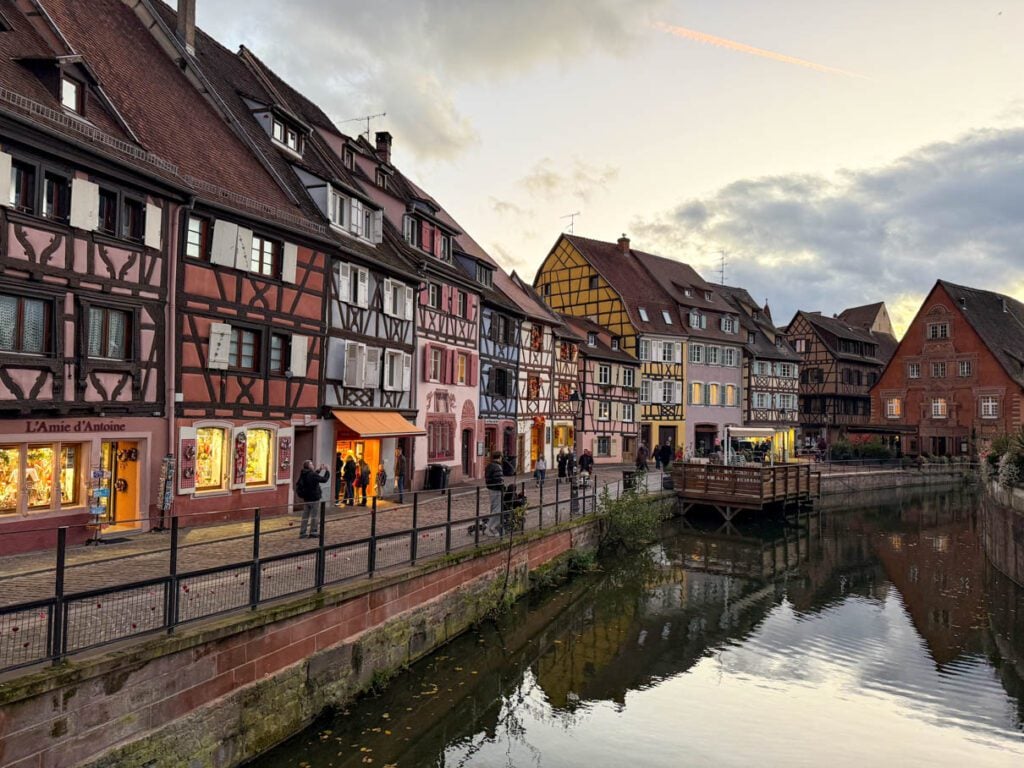
Eguisheim or Riquewihr
- Best For: Total village immersion, waking up in a fairytale, romantic getaways
Want the full Alsatian village experience? Stay right in one of these Wine Route gems. You’ll trade convenience and dining options for pure charm. Imagine opening your shutters to cobblestone streets, half-timbered houses, and vineyard views. This works best if you’re staying 3+ nights in Alsace, allowing you to slow down and really soak in village life.
Eguisheim is slightly less touristy and more authentically lived-in, while Riquewihr is more polished and picture-perfect but gets absolutely slammed with day-trippers between 10am-4pm. Both empty out beautifully in the evenings.
- Charming Inn ($$$): Hostellerie du Château in Eguisheim – Family-run for generations, this inn offers rooms with vineyard views, an excellent restaurant, and that personal touch you can’t get in city hotels. €150-250 per night.
- Mid-Range B&B ($$): La Cour de Lise in Eguisheim – A beautiful chambres d’hôtes (B&B) with just a few rooms, each decorated with antiques and Alsatian charm. The breakfast spread is incredible. €110-160 per night.
- Budget Village Stay ($): Gîtes and apartments – Search on Booking.com or Airbnb for self-catering apartments in smaller Wine Route villages like Kaysersberg, Ribeauvillé, or Turckheim. You’ll find charming options for €60-100 per night, often with kitchens so you can shop at local markets and save on dining costs.
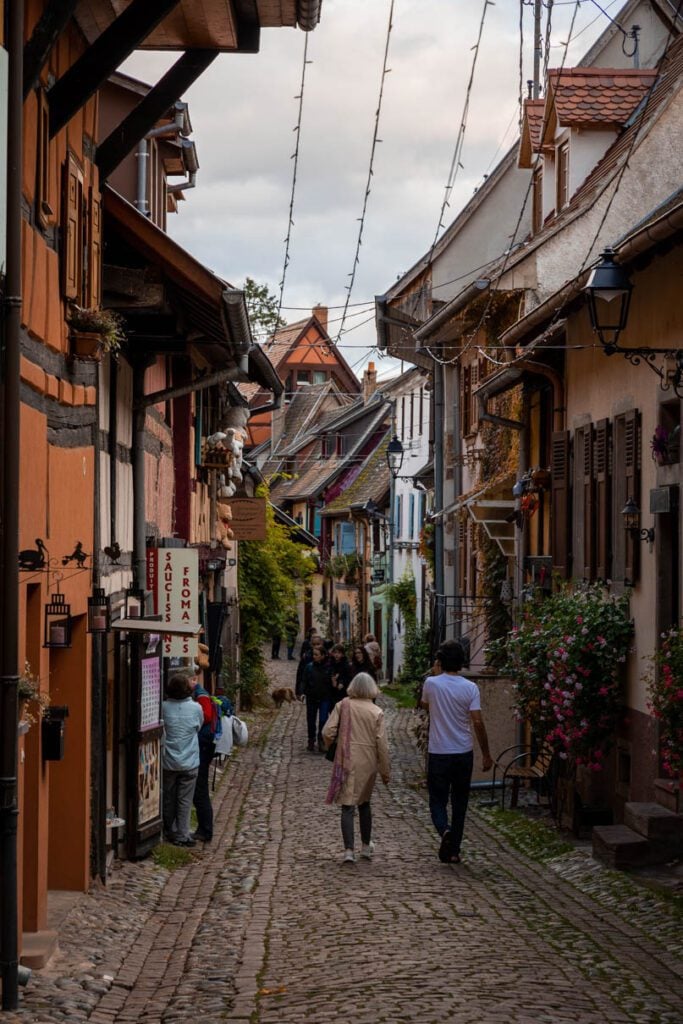
My Recommendation
Here’s my general rule of thumb on where to stay in Alsace…
For a first visit: Base yourself in Colmar for 3-4 nights to explore the Wine Route, then move to Strasbourg for 2 nights to experience the city. This gives you the best of both worlds.
For a romantic getaway: Skip the cities entirely and stay in Eguisheim or a small village. You’ll fall asleep to silence and wake up to church bells.
For Christmas markets: Definitely stay in Strasbourg…you’re at ground zero for Europe’s best markets, and the atmosphere is unbeatable.
My Favorite Places to Visit in Alsace
From scenic vineyards with wine tastings to charming villages with some of Europe’s best Christmas Market spots, here are all the top locations and experiences in Alsace.
1. Alsace Wine Route
The Alsace Wine Route is a 170km stretch of pure magic winding through vineyards, fairytale villages, and rolling hills. I’m giving it the top spot because it combines everything I love: incredible scenery, world-class wine, and those half-timbered villages that look like they were designed by Disney.

This route runs from Marlenheim in the north to Thann in the south, cutting through the heart of Alsace’s wine country. You’re talking Riesling, Gewürztraminer, Pinot Gris, and Crémant d’Alsace…some of the best white wines on the planet.
The villages along the route are unreal: think colorful medieval houses, flower boxes overflowing with geraniums, and cobblestone streets that haven’t changed in centuries. You’ll pass endless vineyards with the Vosges Mountains as your backdrop. Best part? You can stop at family-run wineries, taste straight from the source, and actually afford the bottles (unlike Burgundy).
I’ll be breaking down the specific villages and wineries worth visiting below. But trust me…rent a car, take your time, and prepare for one of the most scenic wine experiences in Europe.
- Tasting Alsace wines? This Alsace Wine Route small-group tour from Strasbourg delights.

2. Riquewihr
If you only visit ONE village on the Alsace Wine Route, make it Riquewihr. This place is absurdly beautiful…like someone built a medieval village, preserved it perfectly for 500 years, and dropped it in the middle of vineyards.
The entire town is pedestrian-only, with those iconic colorful half-timbered houses lining cobblestone streets. Every corner is Instagram gold, but it’s not just pretty…Riquewihr is a serious wine village. It’s surrounded by Grand Cru vineyards producing some of Alsace’s best Riesling and Gewürztraminer.
Hit up Maison Hugel or Dopff au Moulin for tastings, wander through the Dolder Gate (the 13th-century tower), and just get lost in the winding alleys. The Rue du Général de Gaulle is the main drag lined with wine shops and tasting rooms.
What I love most? Despite the tourists, Riquewihr still feels authentic. The winemakers are locals, the architecture is real (not reconstructed), and you can taste wines where they’re actually made. I recommend going early morning or late afternoon for the best experience.
- Wandering Riquewihr’s medieval streets? Join this private Riquewihr walking tour for local insights.

3. Kaysersberg
Kaysersberg stole my heart. After walking around, the name suddenly made perfect sense. Kaysersberg literally means “Emperor’s Mountain,” and this place has that imperial, commanding beauty.
What makes it one of my favorites? It has everything Riquewihr has—those incredible half-timbered houses, cobblestone streets, vineyards—but with a more authentic, less touristy vibe. You can actually breathe here.
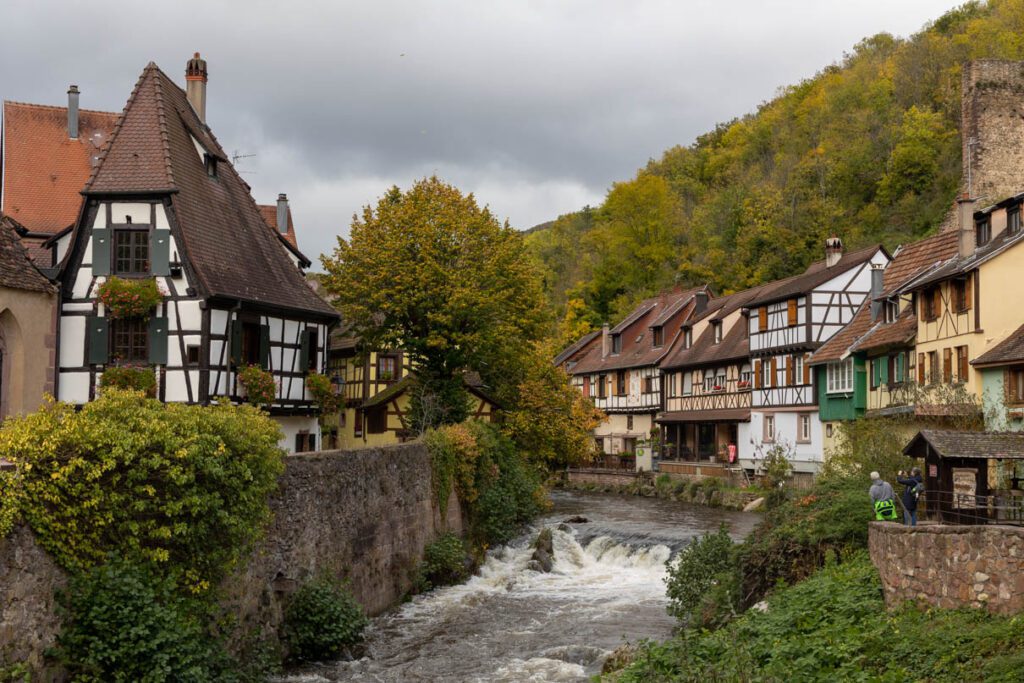
The fortified bridge over the Weiss River is iconic (and ridiculously photogenic), and the castle ruins perched on the hill above town offer killer views over the village and vineyards. Climbing up there at sunset? Absolutely worth it.
The town itself feels lived in. Real locals, excellent wine shops where people actually take time with you, and restaurants that aren’t just catering to tour buses. Albert Schweitzer was born here, and there’s a museum if you’re into that.
Kaysersberg also nails that perfect balance: touristy enough to have great infrastructure, but quiet enough to feel like you discovered something special. Walk the main street, explore the side alleys, grab wine from a local producer, and just soak it in. This is the Alsace village I’d move to. Hands down!
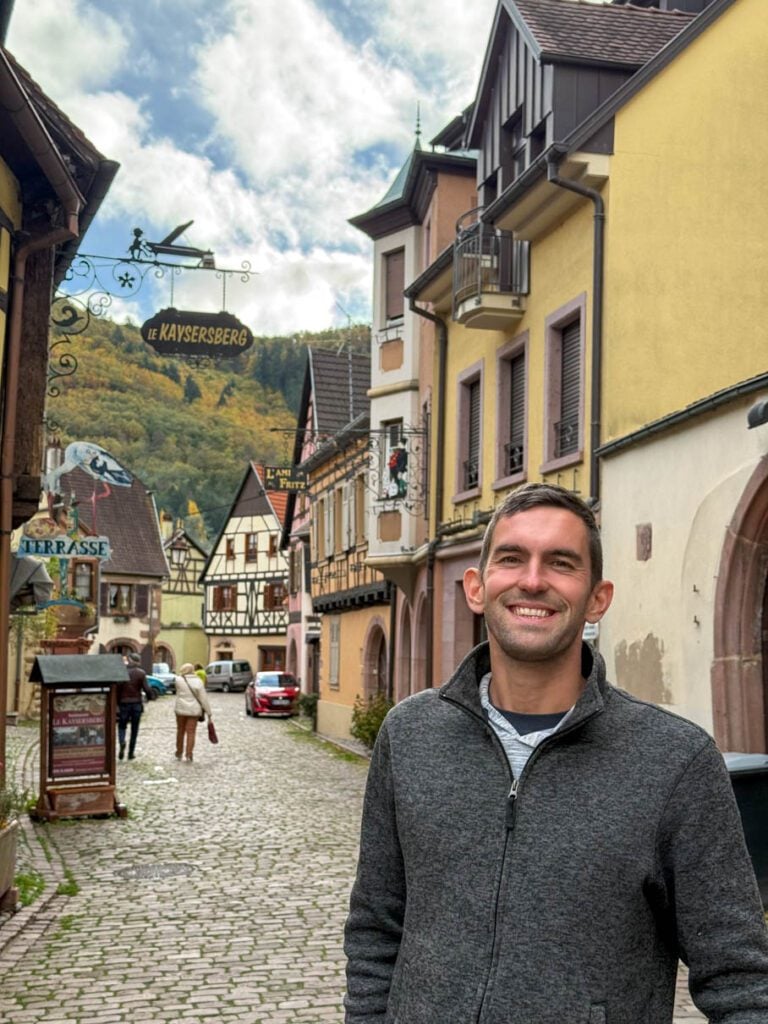

4. Strasbourg
This city is the perfect blend of French charm and German character, and you feel it everywhere.
Start at La Petite France, the old quarter with half-timbered houses, cobblestone streets, and canals that look straight out of a storybook. It’s ridiculously photogenic. Then head to the Strasbourg Cathedral, that pink sandstone Gothic masterpiece will blow your mind. Climb the 330 steps to the platform for views over the entire city.

Wander along the Ill River canals and explore Place Kléber in the city center. Don’t skip the Covered Bridges (Ponts Couverts) for that classic Strasbourg shot.
And honestly? Just get lost in the streets. Duck into a winstub (traditional Alsatian restaurant) for tarte flambée and local wine. The mix of French elegance and German coziness makes Strasbourg feel unlike anywhere else in France.
If you’re hitting Alsace, Strasbourg is non-negotiable. Between the architecture, the food, and that unique cross-cultural vibe, it’s one of those places I could visit again and again.
- Experience Strasbourg Cathedral with the immersive LUMINISCENCE 360° light show firsthand.
- Read next: My Strasbourg Travel Guide

5. Château du Haut-Kœnigsbourg
Perched 750 meters above the Alsace plain, this medieval fortress is straight out of a fantasy novel…and touring it was one of my favorite experiences in the region.
The castle itself is incredible: a fully restored 12th-century fortress with towers, ramparts, and panoramic views that stretch across the Rhine Valley all the way to Germany and the Black Forest. You can explore the interior rooms, climb the towers, and walk the defensive walls while imagining what life was like for medieval knights.

But here’s what really got me: I visited in fall, and the surrounding Vosges Mountains were absolutely ablaze with autumn colors. Reds, oranges, golds…the entire countryside looked like it was on fire. Those fall hues meshing with the castle’s pink sandstone walls and terracotta rooftops? Chef’s kiss. The scenery was next-level gorgeous.
The drive up to Château du Haut-Kœnigsbourg is winding and scenic, and once you’re at the top, you feel like you’re ruling over all of Alsace. Touring the castle takes about 1-2 hours, but factor in extra time to just soak in those views. If you can time it for fall, do it. The combination is unbeatable.
- Fall colors and medieval charm await on this Haut-Koenigsbourg Castle and Alsace villages tour.
- Read next: My Favorite Mountains to Visit in France

6. Vosges Mountains
Speaking of Château du Haut-Kœnigsbourg…those epic views from the castle? That’s the Vosges Mountains stealing the show. And while the castle gives you a taste of the scenery, actually getting into the Vosges is when things get really good.
These mountains form the natural border between Alsace and the rest of France, and they’re seriously underrated. We’re talking rolling peaks covered in dense forests, alpine meadows, and hiking trails that range from easy walks to challenging climbs.
Route des Crêtes (Crest Road) is the must-do drive…a scenic mountain road that winds along the ridgeline with panoramic views over both sides. Stop at Grand Ballon, the highest peak in the Vosges at 1,424 meters, for 360-degree views that’ll make you forget you’re not in the Alps.

The hiking here is fantastic. Trails take you through beech and pine forests, past mountain lakes, and up to viewpoints overlooking the Alsace wine country below. In fall, the foliage is insane…those autumn colors I mentioned earlier are everywhere.
The Vosges also has charming mountain villages, local farms selling Munster cheese, and a totally different vibe from the wine route valleys. It’s the perfect contrast to Strasbourg and the villages.

7. Colmar
Colmar is easily one of the most scenic towns in Alsace, and honestly, one of the most beautiful in all of France. It’s incredibly photogenic, with pastel half-timbered houses reflecting in quiet canals, cobblestone lanes filled with flowers, and cafés that look straight out of a storybook. Yes, it’s very touristy, especially in summer and around Christmas, but there’s a good reason for that…it’s just that magical.

I’ve been to Colmar twice, most recently during a fall road trip through Alsace, and it somehow feels new each time. I love wandering through Little Venice, the most picturesque quarter in town, where every corner looks like a postcard. The Old Town is compact enough to explore on foot, and I always stop by Marché Couvert, the local market by the canal, for cheese, pastries, and wine tastings.
Don’t miss the Musée Unterlinden for a dose of history, or rent a bike to explore the nearby vineyards. If you visit around December, the Christmas markets transform Colmar into a winter fairytale…it’s truly one of Europe’s best.
My tip: stay overnight. Most day-trippers leave by late afternoon, and when the crowds fade and the lights reflect on the canals, Colmar feels even more enchanting.
- Wandering Colmar’s canals? This self-guided interactive Colmar city tour makes exploring fun and flexible.
- Read next: Trip Planning Tips for Visiting Colmar

8. Eguisheim
Eguisheim is a storybook village that feels like stepping back in time, with circular cobblestone streets, half-timbered houses, and vibrant flower displays. Voted one of France’s most beautiful villages, it’s a must-visit for its charming atmosphere and deep history. Walking through its winding lanes, I stumbled upon St. Peter and St. Paul Church, a Romanesque gem with intricate stained-glass windows. The town’s unique circular layout, centered around Eguisheim Castle, makes exploring feel like an adventure.
This village is also famous for its vineyards and exceptional wine production, particularly Riesling and Gewürztraminer. Many wineries offer intimate tastings where you can learn about Alsace’s winemaking traditions firsthand. If you visit in August, the Eguisheim Wine Festival showcases the best local wines, music, and folklore. For those seeking an authentic and picturesque Alsatian experience, Eguisheim is the perfect stop.
- Discover Eguisheim’s charm with this private Alsace day tour from Strasbourg visiting Colmar, Riquewihr, and magical villages.

9. Obernai
While everyone flocks to Riquewihr and Colmar, Obernai flies under the radar, and that’s exactly why I loved it. We actually stayed overnight here, and it turned out to be one of the best decisions of our Alsace trip.
This town is gorgeous. We’re talking the full Alsace package: colorful half-timbered houses, flower-lined streets, medieval ramparts, and the stunning Place du Marché with its town hall and Renaissance well. The Kapellturm (chapel tower) and old fortifications give it serious medieval vibes.
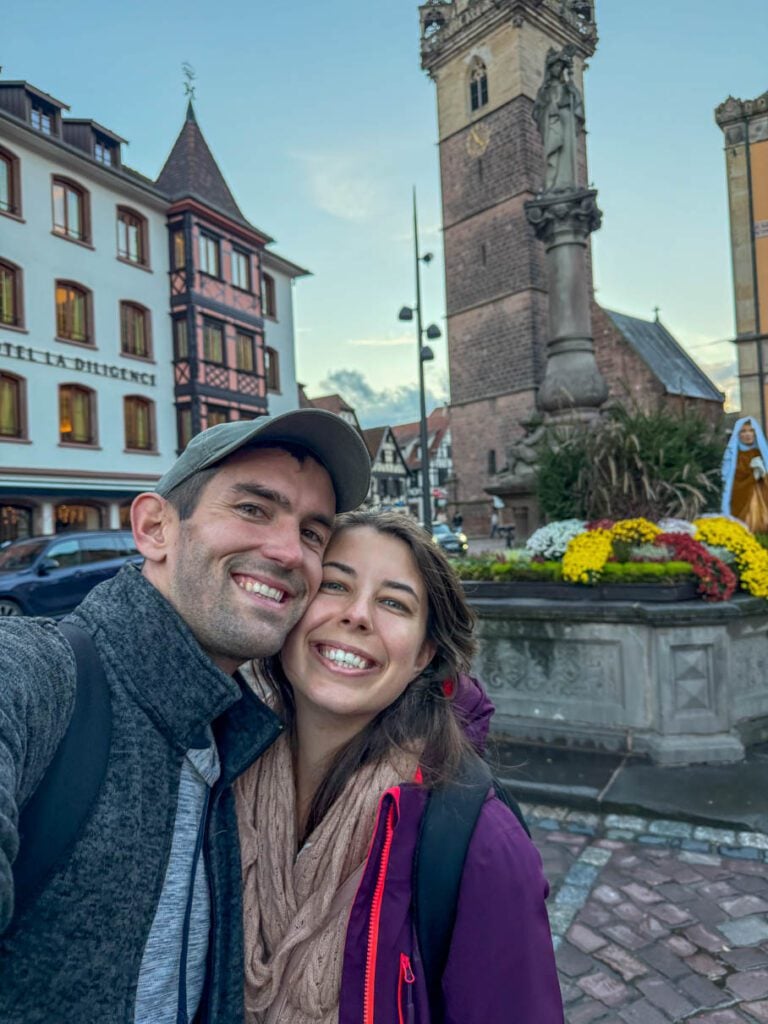

But here’s what sets Obernai apart: it’s a hidden gem with way fewer tourists than the famous villages, so you actually get to experience authentic Alsatian life. Locals shopping at the market, cafés filled with residents, wine bars where you’re not fighting for space.
The location is clutch. Obernai sits perfectly positioned between Strasbourg (30 minutes north) and the main Wine Route villages (15-20 minutes south). You can easily day-trip to Riquewihr, Kaysersberg, or Château du Haut-Kœnigsbourg, then come back to a peaceful town at night.
Staying overnight meant I got to experience Obernai after the day-trippers left…wandering the quiet streets, having dinner at a local winstub, and waking up to that small-town charm. Seriously underrated!
10. Mont Sainte-Odile
Perched atop the Vosges Mountains, Mont Sainte-Odile is a spiritual retreat offering breathtaking panoramic views and a rich history dating back to the 7th century. The monastery, founded by Saint Odile, the patron saint of Alsace, remains a pilgrimage site and a place of reflection. Walking through its ancient stone corridors, I felt a deep sense of peace, especially in the chapel adorned with beautiful frescoes. Outside, the Terrace of the Angels provides stunning views of the Rhine Plain and Black Forest.
Surrounding the monastery are hiking trails, including paths leading to mysterious Pagan Walls, whose origins remain debated. Whether you’re interested in history, spirituality, or nature, Mont Sainte-Odile offers a unique experience. Watching the sunset over the valley from this mountaintop sanctuary is an unforgettable moment that captures the magic of Alsace’s landscapes and heritage.
- Seeking panoramic views? This Mont Sainte-Odile private excursion from Strasbourg offers history, hiking, and breathtaking Alsace scenery.

11. Bergheim
Sometimes the best travel moments are the ones you don’t plan. We drove into Bergheim completely by accident, saw the medieval gate tower, and figured “why not?” We then ended up discovering one of Alsace’s best-kept secrets.
This place is a total hidden gem. Like, actually hidden. Almost zero tourists, perfectly preserved medieval fortifications, and those classic Alsatian half-timbered houses without the crowds you get in Riquewihr or Colmar. The town still has its original ramparts from the 14th century, and you can walk along sections of the old defensive walls.

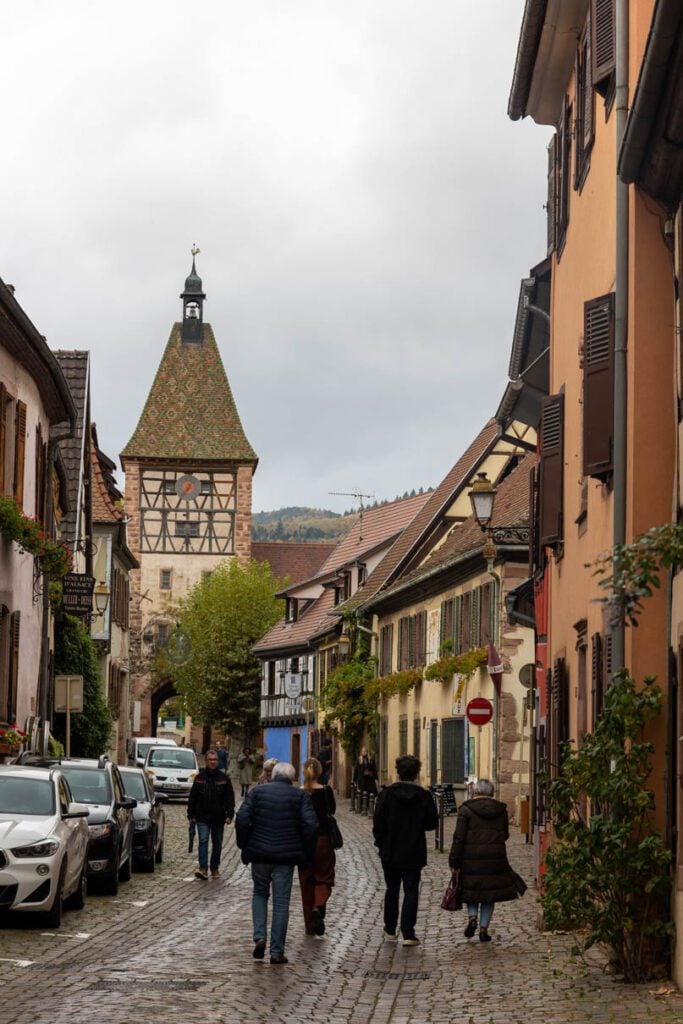
The streets are quiet, authentic, and absolutely beautiful. Flowers everywhere, cobblestones, locals going about their day like tourism hasn’t completely taken over. But here’s the real highlight: we grabbed chocolate croissants from a local bakery, and I’m not exaggerating…one of the best I’ve ever had. Flaky, buttery, with actual chunks of dark chocolate inside. After 70 countries and countless pastries, that’s saying something.
Bergheim isn’t on most Alsace itineraries, which is exactly why you should add it. Stop for an hour, grab pastries, wander the walls, and enjoy a slice of Alsace that still feels completely undiscovered. Sometimes getting “lost” is the best navigation!
FAQs About Visiting Alsace
Here are some popular questions I’ve received from my recent trip to Alsace.
Is Alsace worth visiting year-round?
Absolutely. Each season has its charm. Fall (when I visited) brings those incredible autumn colors in the Vosges Mountains and harvest season in the vineyards. Winter is magical…Alsace has some of Europe’s best Christmas markets, especially in Strasbourg and Colmar. Spring means blooming flowers and fewer crowds. Summer is peak season with perfect weather, but expect more tourists. Honestly, you can’t go wrong.
Can I visit Alsace without a car?
You can, but you’ll be limited. Strasbourg and Colmar are easy to reach by train and walkable. But the Wine Route villages and places like Château du Haut-Kœnigsbourg? Much harder without a car. Buses exist but are infrequent. If you’re serious about exploring the region properly, rent a car. It’s worth it.
What is the best town to stay in?
I stayed in Obernai and loved it. Perfect location between Strasbourg and the Wine Route, beautiful town, fewer tourists, and you can day-trip everywhere. Strasbourg is great if you want city vibes and don’t mind driving 30 minutes to wine country. Colmar works if you want to be right in the heart of it all.
How many days do you need?
Minimum 3-4 days to hit the highlights (Strasbourg, a few Wine Route villages, maybe the castle). Ideally 5-7 days if you want to really explore, do wine tastings, hike the Vosges, and not feel rushed. I could’ve easily spent a week here.
What’s the difference between Colmar and Strasbourg for first-timers?
Strasbourg is a proper city…bigger, more cosmopolitan, with major sights like the cathedral and European Parliament. It feels more urban and has that French-German blend culturally.
Colmar is smaller, more intimate, and feels like a fairytale village (even though it’s technically a town). It’s all about the old-world charm, canals, and being closer to the Wine Route villages.
If you only have time for one, I’d say Strasbourg for the full experience. But honestly, you should see both.





